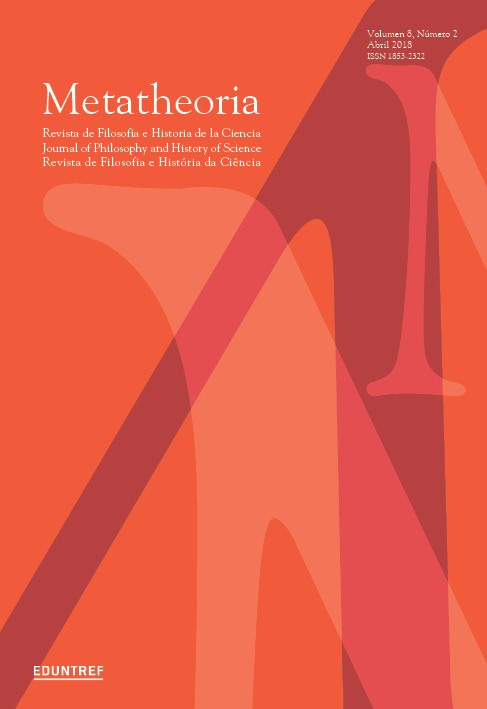Natural Kinds in the Brain Sciences: The Debate is Still Alive
DOI:
https://doi.org/10.48160/18532330me8.174Keywords:
multiple realizability, natural kinds, brain sciencesAbstract
In this article we analyze Brain Sciences classifications as a room for assessing, updating and improving our current ideas about multiple realizability (MR) and Biology’s natural kinds (NKs) debate. Multiple realizability, the possibility of achieving a goal by several causally unexpected means has historically being a displeasing position. Nonetheless, it has permeated distant fields of the original debate such as Brain Sciences. It has been tought that the success of neuro-sciences rests in four claims: 1) Interspecific comparisons; 2) Continuity of neural mechanisms across species; 3) Uniqueness of functions of the brain; 4) Acommon neural grain. In this article, we refer to evidence from Comparative Neuroanatomy across species, specifically to hypothesis and rules of brain evolution among species, and the Human Brain Project, to cast doubts about 1-4. This will allow us to attest that multiple realizability cannot be precluded in current Brain Sciences.
References
Aizawa, K. (2009), “Neuroscience and Multiple Realization: A Reply to Bechtel and Mundale”, Synthese167: 493-510.
Bechtel, W. y J. Mundale (1999), “Multiple Realizability Revisited: Linking Cognitive and Neural States”, Philosophy of Science66(2): 175-207.
Bechtel, W. (2008), Mental Mechanisms: Philosophical Perspectives on Cognitive Neuroscience, New York: Routledge.
Bickle, J. (1998), Psychoneural Reduction: The New Wave, Cambridge: MIT Press.
Boyd, R.N. (1990), “Realism, Approximate Truth, and Philosophical Method”, en Savage, C.W. (ed.), Scientific Theories,Minneapolis: University of Minnesota Press, pp. 355-391.
Boyd, R.N. (1991), “Realism, Anti-Foundationalism and the Enthusiasm for Natural Kinds”, Philosophical Studies 61(1-2): 127-148.
Boyd, R.N. (1999a), “Kinds, Complexity, and Multiple Realization”, Philosophical Studies95(1-2): 67-98.
Boyd, R.N. (1999b), “Homeostasis, Species, and Higher Taxa”, en Wilson, R.A.(ed.), Species: New Interdisciplinary Essays, Cambridge: MIT Press, pp. 141-85.
Boyd, R.N. (2000), “Kinds as the ‘Workmanship of Men’: Realism, Constructivism, and Natural Kinds”, en Nida-Rümelin, J. (ed.), Rationalität, Realismus, Revision: Vorträge des 3. Internationalen Kongresses der Gesellschaft für Analytische Philosophie, Berlín: De Gruyter, pp. 52-89.
Craver, C.(2007), Explaining the Brain: Mechanisms and the Mosaic Unity of Neuroscience, Oxford: Oxford UniversityPress.
Ebbesson, S.O.E. (1980), “The Parcellation Theory and its Relation to Interspecific Variability in Brain Organization, Evolutionary and Ontogenetic Development, and Neuronal Plasticity”, Cell & Tissue Research213(2): 179-212.
Ereshefsky, M. y T.A.C. Reydon (2015), “Scientific Kinds”, Philosophical Studies172(4): 969-986.
Figdor, C.(2010), “Neuroscience and the Multiple Realization of Cognitive Functions”, Philosophy of Science77(3): 419-456.
Fodor, J.A. (1974), “Special Sciences: Or the Disunity of Science as a Working Hypothesis”, Synthese 28: 97-115.
Gallese, V., Fadiga, L., Fogassi, L. y G. Rizzolatti (1996), “Action Recognition in the Premotor Cortex”, Brain119: 593-609.
Grene, M. y E. Mendelsohn(eds.) (1976), Topics in the Philosophy of Biology, Dordrecht: Springer.
Hernández Chávez, P. (2016), Modularidad cognitiva y especialización cerebral, México: CEFPSVLT.
Hodos W. y A.B. Butler (1997), “Evolution of Sensory Pathways in Vertebrates”, Brain, Behavior and Evolution50(4): 189-197.
Kim, J.(1992), “Multiple Realization and the Metaphysics of Reduction”, Philosophy and Phenomenological Research52: 1-26.
Medina L. y A. Reiner (2000), “Do Birds Possess Homologues of Mammalian Primary Visual, Somatosensory and Motor Cortices?”, Trends in Neurosciences23(1): 1-12.
Nieuwenhuys, R., Donkelaar, H.J.T. y C. Nicholson (2014), The Central Nervous System of Vertebrates, Vol.3, Dordrecht: Springer.
Northcutt, R.G. (1984), “Evolution of the Vertebrate Central Nervous System: Patterns and Processes”, American Zoologist24(3): 701-716.
Piccinini, G. y C. Craver (2011), “Integrating Psychology and Neuroscience: Functional Analysis as Mechanism Sketches”, Synthese183(3): 283-311.
Preuss, T.M. y G.Q. Coleman (2002), “Human-Specific Organization of Primary Visual Cortex: Alternating Compartments of Dense Cat-301 and Calbindin Immunoreactivity in Layer 4A”, Cerebral Cortex12(7): 671-691.
Putnam, H. (1967), “Psychological Predicates”, en Capitan, W.H. y D.D. Merrill (eds.), Art, Mind, and Religion, Pittsburgh: University of Pittsburgh Press, pp. 37-48.
Shagrir, O.(1998), “Multiple Realization, Computation and the Taxonomy of Psychological States”, Synthese114: 445-461.
Shapiro, L.A. (2000), “Multiple Realizations”, Journal of Philosophy97: 635-654.
Shapiro, L.A. (2004), The Mind Incarnate, Cambridge: MIT Press.
Sullivan, J. (2016), Natural Kinds and Classification in Scientific Practice, Abingdon, NY: Routledge.
Striedter, G.F. (2005),Principles of Brain Evolution, Massachusetts: Sinauer Associates.
Thompson, D.W. (1959), On Growth and Form,Vol. I, reimpresión de 1917, Cambridge: Cambridge University Press.
Wilczynski, W. (1984), “Central Neural Systems Subserving a Homoplasious Periphery”, American Zoologist24(3):755-763.
Downloads
Published
How to Cite
Issue
Section
License
Copyright (c) 2018 Metatheoria – Journal of Philosophy and History of ScienceThe documents published here are governed by the licensing criteria
Creative Commons Argentina.Atribución - No Comercial - Sin Obra Derivada 2.5 https://creativecommons.org/licenses/by-nc-nd/2.5/ar/





